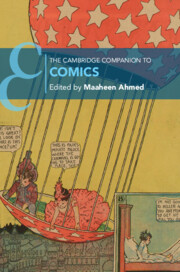Book contents
- The Cambridge Companion to Comics
- The Cambridge Companion to Comics
- Copyright page
- Contents
- Figures
- Contributors
- Acknowledgments
- Chronology
- Introduction
- Part I Forms
- Chapter 1 Comics Drawing
- Chapter 2 Comics, Media Culture, and Seriality
- Chapter 3 Comics and Graphic Novels
- Chapter 4 Manga
- Chapter 5 Digital Comics
- Part II Readings
- Part III Uses
- Further Reading
- Index
- Cambridge Companions To …
- References
Chapter 4 - Manga
An Affective Form of Comics
from Part I - Forms
Published online by Cambridge University Press: 17 August 2023
- The Cambridge Companion to Comics
- The Cambridge Companion to Comics
- Copyright page
- Contents
- Figures
- Contributors
- Acknowledgments
- Chronology
- Introduction
- Part I Forms
- Chapter 1 Comics Drawing
- Chapter 2 Comics, Media Culture, and Seriality
- Chapter 3 Comics and Graphic Novels
- Chapter 4 Manga
- Chapter 5 Digital Comics
- Part II Readings
- Part III Uses
- Further Reading
- Index
- Cambridge Companions To …
- References
Summary
Taking the narrow notion of manga outside of Japan as its starting point, this chapter refrains from introducing the diversity of comics in Japan in support of a transculturally open approach. From a form-conscious perspective, it conceptualizes manga as a highly affective type of comics that share characteristics with non-Japanese comics far beyond the “manga” label. Following a brief historical survey of what “manga” has meant in English since the 1980s, the device of affective eyes takes center stage. Graphic narratives by Osamu Tezuka, Keiji Nakazawa, Keiko Takemiya, and Jirō Taniguchi serve as examples for how extreme close-ups of eyes have operated across periods and genres, namely, not only as representations of interiority or ethnicity, but also as material signposts and guides of visual perception: eyes draw attention, get readers involved prior to critical interpretation, establish intimacy with characters, provide a node for a page’s visual fragments, help to obscure the divide between inside and outside, subject and object, self and other. Moving gingerly into an ocular history of manga as an affective form of comics, the chapter seeks to turn away from essentialist, as well as culturalist, definitions of what manga is in favor of how it operates.
- Type
- Chapter
- Information
- The Cambridge Companion to Comics , pp. 82 - 101Publisher: Cambridge University PressPrint publication year: 2023
References
Primary Sources
Secondary Sources
- 1
- Cited by

